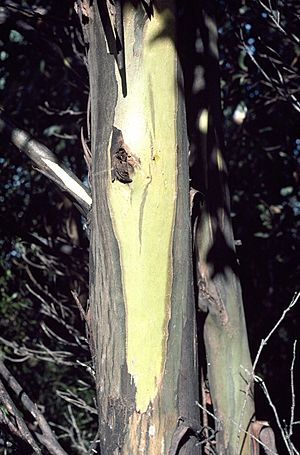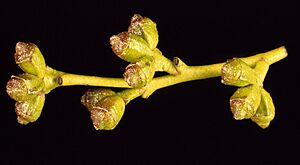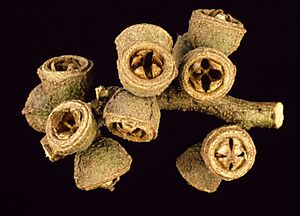Tasmanian yellow gum facts for kids
Quick facts for kids Tasmanian yellow gum |
|
|---|---|
 |
|
| Trunk of E. johnstonii | |
| Scientific classification | |
| Genus: |
Eucalyptus
|
| Species: |
johnstonii
|
The Tasmanian yellow gum (scientific name: Eucalyptus johnstonii) is a special type of tree. It grows only in Tasmania, Australia. It's a medium to tall tree. This tree has smooth bark that can be yellow, brown, or green. Its adult leaves look like spears. Its white flowers grow in groups of three. After flowering, it produces fruit shaped like a half-sphere or a bell.
Contents
What the Tasmanian Yellow Gum Looks Like
The Tasmanian yellow gum is a very tall tree. It can grow up to 40 to 50 meters (about 130 to 160 feet) high! It also has a special woody lump at its base called a lignotuber. This helps the tree regrow if it gets damaged, like by a bushfire.
Bark and Leaves
The bark of this tree is usually smooth. It can be yellow, brownish, or greenish. Sometimes, near the bottom of the tree, the bark might be rough and stringy.
Young Tasmanian yellow gum plants have stems that are almost square. They have a wide, flat edge on each corner. Their leaves are attached directly to the stem without a stalk. These young leaves are egg-shaped or nearly round. They are about 2.5 to 6 centimeters (1 to 2.4 inches) long and 1.3 to 4.5 centimeters (0.5 to 1.8 inches) wide. They grow in pairs, one across from the other.
As the tree gets older, its adult leaves change. They become glossy green on both sides. They are shaped like a spear or are slightly curved. These leaves are about 6.5 to 15 centimeters (2.5 to 6 inches) long and 2 to 4 centimeters (0.8 to 1.6 inches) wide. Each adult leaf has a stalk, called a petiole, which is about 1.5 to 3 centimeters (0.6 to 1.2 inches) long.
Flowers and Fruit
The flower buds of the Tasmanian yellow gum grow in groups of three. They are found where the leaves meet the stem. Each group of buds sits on a thick, short stalk called a peduncle, which is 3 to 10 millimeters long. The individual buds do not have their own stalks.
When the buds are ready to open, they are oblong or diamond-shaped. They are about 8 to 11 millimeters long and 6 to 9 millimeters wide. The top part of the bud, called the operculum, is rounded and has a small knob in the middle.
The Tasmanian yellow gum mainly flowers from February to April. Its flowers are white. After the flowers, the tree produces woody fruit. These fruits are shaped like a half-sphere or a bell. They are about 7 to 10 millimeters long and 9 to 13 millimeters wide. When the fruit opens, the parts that release the seeds stick out above the rim.
How the Tasmanian Yellow Gum Got Its Name
The scientific name Eucalyptus johnstonii was first officially described in 1922. This was done by a famous botanist named Joseph Maiden. He wrote about it in his book, A Critical Revision of the Genus Eucalyptus. The "johnstonii" part of the name honors a person named Robert Mackenzie Johnston.
Interestingly, another botanist, Thomas Bather Moore, had described this tree earlier in 1886. He called it Eucalyptus muelleri. However, that name was already being used for a different tree species. This made Moore's name for the Tasmanian yellow gum "illegitimate" in the world of plant naming. Joseph Maiden then gave it the correct and lasting name.
Where the Tasmanian Yellow Gum Lives
The Tasmanian yellow gum grows in tall forests. You can find it on mountains and high plateaus in southeastern Tasmania. Some places where it grows include Mount Wellington, Bruny Island, and the Tasman Peninsula.



